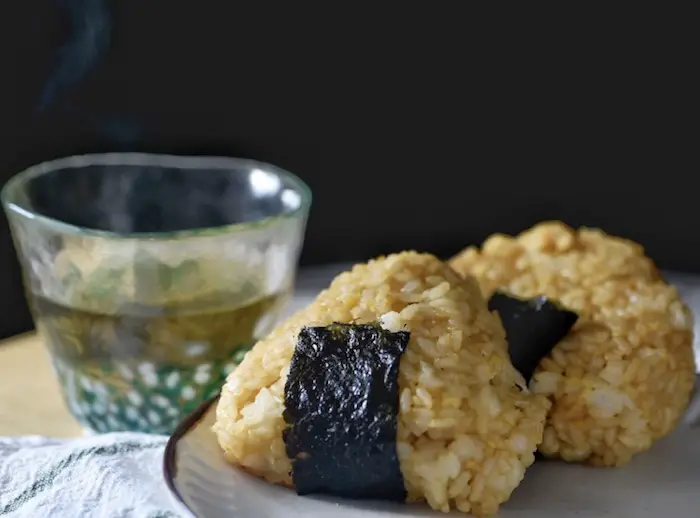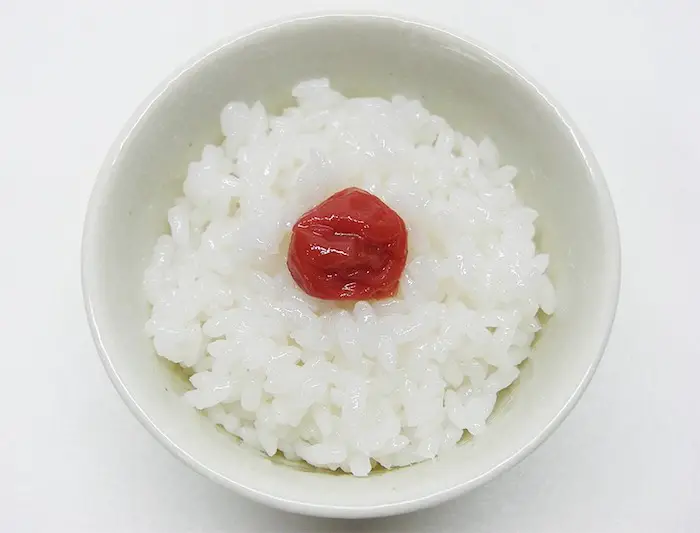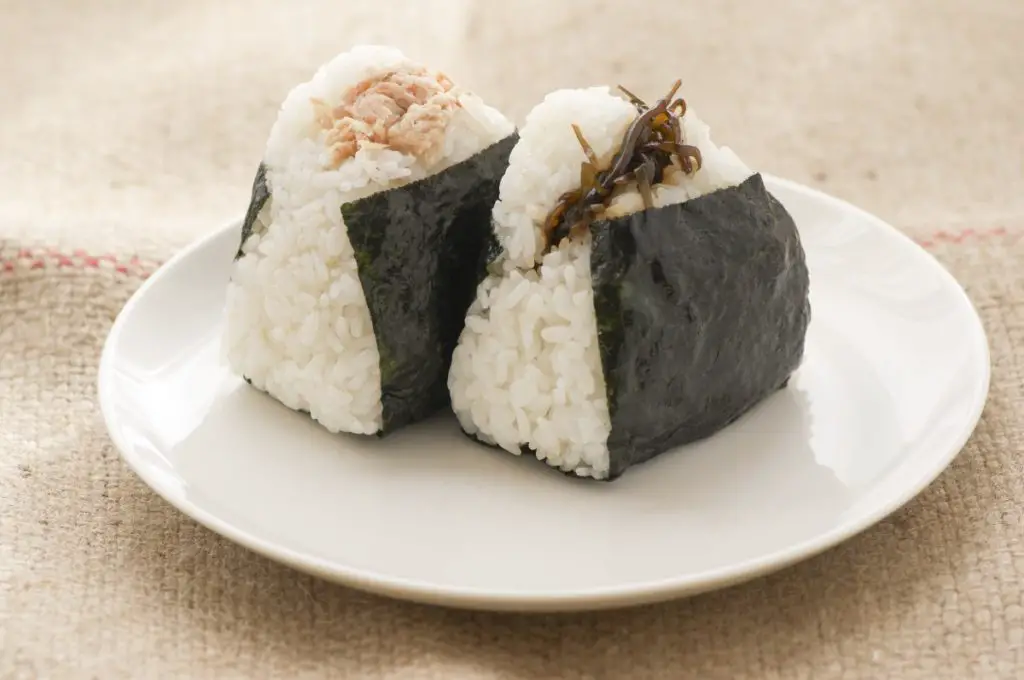We are reader supported. When you purchase through links on our site, we may earn an affiliate commission. Also, as an Amazon affiliate, we earn from qualifying purchases.

I like to call Onigiri or rice balls a close cousin of sushi because of the many similarities between the two dishes. Popular as comfort food in Japan, Onigiri comprises of steamed rice with a nori strip on the outside and savory fillings inside. The most common type of traditional filling is umeboshi or salted plum but you may also use grilled salmon, seasoned kelp, and so on.
With sushi gaining worldwide popularity, many other Japanese dishes have also garnered a lot of attention. Some people even go to the extent of calling Onigiri, a Japanese sandwich. Although you can find Onigiri in almost any Japanese restaurant across the globe, preparing it at home is also a lot of fun. So, if you are thinking ‘what to put in Onigiri’, here are some filling ideas to consider.
#1. Salmon and mayo
Fish and seafood are an integral part of Japanese cuisine and I love salmon, so I would like to start with this savory filling. You may grill a block of salmon, shred it into small pieces using a fork, and mix it with mayo in a small bowl. It tastes great with rice and nori. When used in onigiri, it is called sake or sha-keh, same as the popular Japanese beverage.
#2. Tuna and mayo
Tuna is a much sought after seafood in Japan, and you may choose to use the lean portion of fatty tuna for a richer texture. You may use raw tuna if you get sushi-grade fish in your area or else grill/ bake tuna before shredding it into pieces. Put them in a bowl and mix with mayo. For a more lavish filling, use negitoro or fatty tuna minced and mixed with spring onion.
#3. Grill/ bake salmon
This type of filling is called Shake in Japanese and it’s easy to make at home. Pre-heat your oven and bake a piece of salmon marinated in teriyaki sauce or soy sauce. Once baked, use a fork to shred it into smaller pieces. The filling is not only delicious but also a rich source of vitamin D, protein, and omega-3.
#4. Umeboshi or pickled plum

Known as Ume (ooh-may), this is a type of pickled plum that has a salty and sour taste, which perfectly complements the steamed rice. Besides being a popular traditional ingredient used in onigiri, this filling also serves as a great preservative to keep the dish good for long. Hence, it’s a popular choice for lunch boxes, especially during summer to beat the heat.
#5. Mentaiko
If you love fish eggs then you will enjoy this filling too. Mentaiko is a Japanese name for fresh Pollock or codfish eggs that may be grilled or seasoned with spices and salt. It goes well with steamed rice as well as pasta. If you prefer a spicy version, then add more spices to the fish eggs. You may use different varieties of delicate fish eggs such as ikura or salmon roe.
#6. Tarako or Cod Roe
This is another type of fish eggs prepared by seasoning Pollock or Cod roe (see Amazon). Tarako is the Japanese term for raw eggs, while yaki tarako stands for grilled or cooked versions. When yaki tarako is seasoned with salt, it gets a more delicate flavor than menitaiko.
#7. Kombu or Kelp

Kombu is a type of seaweed and it is prepared by using a special cooking method known as tsukudani. In this method, the seaweed is simmered in soy sauce with mirin, cooking sake, and sugar. You may substitute some of the items with honey, agave, or tamari sauce.
#8. Tempura Shrimp or Tenmusu
Tenmusu is the Japanese name for a dish that is inspired by two different dishes – musubi and shrimp tempura. Mususbi means steamed rice ball and shrimp tempura is the seafood coated in a batter and fried. The crispy texture and savory taste of shrimp tempura go great with white rice.
#9. Ebi or Shrimp with Mayo
If you are a fan of seafood then you will definitely like this one. Ebi is a large-sized Japanese tiger prawn used in sashimi or sushi. You may use fresh or frozen ebi shrimp, cut them into chunks, and seasoned with salt, pepper, and mayo to have a delicious filling for onigiri.
#10. Seasoned Bonito Flakes
I am sure anyone who loves Japanese food has some time or the other eaten bonito flakes. They are easily available at any Asian grocery store. Mix a small portion of bonito flakes with mirin, soy sauce, and salt to make an umami-packed filling for your onigiri.
#11. Japanese fried chicken
If seafood is not your thing, consider using chicken as fillings instead. In Japanese, fried chicken is known as karaage and it’s a delicious filling to be used inside rice balls. To prepare the filling, simply cut the fried chicken into small pieces and stuff this inside seasoned rice balls. You may also use frozen chicken nuggets in the place of fried chicken.
#12. Miso beef
If you want your onigiri fillings to be rich and heavy then here’s a quick miso beef recipe for you. In a bowl, mix together miso, a little water, mirin, garlic (minced), and ginger (grated). Slice the beef into two-inch strips and transfer to the bowl. Heat oil in a pan and cook the mixture until it’s well cooked and dry. Season with salt and pepper.
#13. Japanese mustard plant
Also known as Takana, this is a Japanese mustard plant, a very famous traditional filling used in onigiri. It tastes salty and sour like pickles, but goes really well with steamed seasoned rice.
#14. Boiled Shrimp
If you are a shrimp fan then you will definitely like this one. For this filling, we use tiny shrimps and boil them well. Once they are boiled, season with salt and pepper to enjoy a deliciously sweet and spicy blend that tastes very much like Teriyaki.
#15. Vegetable filling
Vegans and vegetarians have numerous interesting options when it comes to choosing onigiri. The fillings may include daikon radish leaf, matsutake mushroom, Japanese leek, and a variety of other colorful vegetables for a highly appetizing treat.
#16. Natto

This is a highly nutritious fermented soybean widely available in Japan and you may find them in Asian grocery stores. Although they are extremely healthy and taste great, let’s not forget that natto (see Amazon) requires an acquired taste.
#17. Bell pepper and Peanut butter
In a small bowl, cut small pieces of roasted bell pepper and mix it with one tablespoon peanut butter and half teaspoon grated ginger, pepper, and salt. Use this as a creamy and savory filling inside the rice balls.
#18. Walnut and miso
This is another purely vegan onigiri filling. To prepare the mixture, chop a walnut into small pieces and mix this with miso paste. We like the crunchy texture of walnut with the creaminess of miso.
#19. Edamame and sesame seeds
Edamame or the immature pods of soybean are a popular part of Japanese cuisine. You can create a delicious filling by mixing one-fourth cup of edamame with two tablespoon of sesame seeds to enhance the flavor.
#20. Avocado and lime
If you are an onigiri beginner, you will be surprised by the variety of vegan and vegetarian options available. To create a savory filling, mix finely chopped pieces of avocado with zesty lime for a refreshing and tasty flavor.
#21. Takikomi gohan
This is a Japanese name for a mix of vegetables, fish, or meat. So, you may finely chop any 2-3 vegetables or make a mix of fish or meat for a nutritional dish.
#22. Grilled beef rib
This may appear like an unusual choice for many but this is one of the popular fillings used to stuff the rice balls. First, you need to grill marinated beef rib and then shred it into small bits with the help of a fork.
#23. Nikumaki onigiri
This is especially for my pork loving friends and this filling is prepared by soaking and then cooking pork in a soy sauce base. Chop it into small pieces or shred it like fish to make to easily stuff inside the rice ball.
#24. Eel
Those who have not eaten eel before finding it difficult to get used to the taste and others find it’s sliminess off-putting. However, once you get a hang of the taste, it easy to get hooked to it. Eel is grilled or baked first and it may then be chopped into smaller pieces.
#25. Omelet and sauce
When talking about Japanese omelet, we feel that the sweet and savory tamagoyaki could be a nice ingredient to stuff inside onigiri. Cut a block of tamago into small pieces and mix it with tomato sauce to get a savory filling.
#26. Azuki beans
This is another fully vegan filling made from red small beans that should be properly soaked the night before. Pressure cook it well with water and then cook with soy sauce, salt, and pepper before using as fillings.
#27. Green onion with miso
If you are in a hurry then here’s a quick recipe to prepare a tasty and savory filling with finely chopped green onions and miso.
#28. Korean BBQ beef or kalbi

Also known as kalbi, fans of Korean-style barbeque beef can also use it as fillings for onigiri. Shred the meat into smaller pieces and then stuff it inside a ball of rice.
#29. Shredded Cheese
When you are in a hurry and need a quick savory filling for your onigiri, then a block of cheese can come handy. Shred the cheese into smaller pieces and mix it with salt, pepper, cilantro, and green scallions (optional).
#30. Deep-fried pork cutlet or Tonkatsu
If you have a few pieces of cutlet left from last night then a good way of putting them into use is to cut them into smaller pieces. You may now use this mixture as a delicious stuffing with a ball of rice.
8 Tips To Help You Make Perfect Onigiri

The Japanese rice balls or Onigiri are one of the easiest to prepare dishes as they just need a few easily available ingredients – rice, strips nori sheets, and fillings of your choice. You may add toppings or garnishing to adorn the balls further but these are optional. Here are some useful tips to make perfect onigiri:
#1. Always use freshly prepared rice
After the rice is cooked to the perfect texture, wait for some time to let the rice cool down a bit so that you can handle them without burning your hand. However, make sure that the rice is warm enough and not completely cold or else you will not be able to mold them.
#2. Keep a bowl of water
When making rice balls, don’t forget to wet your hands to prevent the rice from sticking on your fingers. Keep a bowl of water close to the ingredients so that you don’t forget this step before grabbing a ball of warm rice. You may also add a few drops of vinegar to the water.
#3. Spread salt on your hands
Take a dollop of salt on your palm and rub both hands to spread it all around. This is an essential step that helps in flavoring the rice balls and also acts as a natural preservative to keep the onigiri good for longer.
#4. Apply a little pressure
When shaping a ball of steamed rice, apply gentle but firm pressure to the ball to shape it into a triangle, cylinder, or sphere shape. Don’t overdo the pressure or squeeze too much, or else the rice may fall apart.
#5. Use a cling film to mold the rice
If you don’t want to use your hands while molding the rice, you may use a cling film in order to handle hot rice without feeling the heat. As a beginner, if the first few attempts don’t come up as desired, it’s okay because the dish will still taste fine.
#6. Get a rice ball mold
If you lack skills to mold the rice and you wish to make perfect onigiri to impress friends in a party then consider getting one of those plastic rice ball moulds. They are easy to use and you can make several balls in less time.
#7. Use short-grain rice for onigiri
Always use the short-grain (new crop variety) for making onigiri as it has a sticky texture that works best for making moulds. If you choose the long-grain rice, they will not stick well and fall apart, making it difficult to form a rice ball.
8. Consume immediately for best results
If you want to enjoy onigiri at its best, consume it immediately while the nori wrap is still crisp. After some time, the nori becomes soggy and it will not have the same effect.
Different types of Onigiri (Japanese Rice Balls)
These tasty and savory rice balls may be formed into different shapes – cylindrical, triangle, and round. Besides the difference in shapes, onigiri may also differ in the way they are presented. Here are the various types of the dish:
Wrapped onigiri is the most common type that comes to the mind when we talk about this dish. It is triangle-shaped rice wrapped in a thin sheet of nori.
If wrapped rice balls are not your thing then consider the salted and seasoned varieties. After you form the balls into your desired shape, garnish it with toasted sesame seeds, furikake toppings, or ground shiso leaves.
Yaki-onigiri is a variety where the balls are toasted over an open flame or a cast iron skillet until the exterior becomes golden-brown and crispy. It may then be coated in a sauce or tasty miso butter to enhance flavors.
Mixed rice onigiri is the healthier alternative to the basic onigiri made from simple white rice. The mixed rice variety may include brown rice and other healthy grains. It may be garnished with toasted sesame seeds.
Related Questions
What’s the difference between onigiri and sushi?
The biggest difference between the two is that onigiri is made from plain steamed rice while sushi includes seasoned rice mixed with vinegar and salt. Furthermore, unlike sushi, onigiri has fillings stuff inside a closed ball of rice.
Related Article: Difference Between Nigiri, Sashimi, Sushi Roll, Hand Roll, Gunkan Sushi
What’s the best way to save onigiri for the next day?
If you have a lot of leftovers from an onigiri dinner, and you want to save it for the next day or you simply wish to make your breakfast in advance wrap the rice balls in a plastic wrap and then with a thick kitchen towel. This will prevent the rice from getting too cold or hard inside the refrigerator.
Related Article: How to Eat Onigiri (Rice Ball)?
How can you warm up cold onigiri?
If you like your onigiri to be a little warm like freshly-made then we suggest that you slightly brush the rice balls with sesame oil and toast it for 2-3 minutes per side on the pan. This will make the outer layer toasty and crispy with a light brown color.
See Also:
(Gimbap) Kimbap vs Sushi Detailed Explanation
Can you make Sushi without Rice Vinegar?
What Is Oba In Sushi? Read This First!
Is All Sushi Raw Or Cooked?

